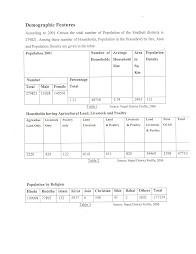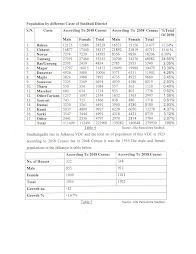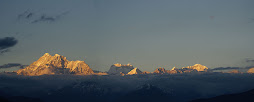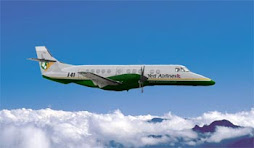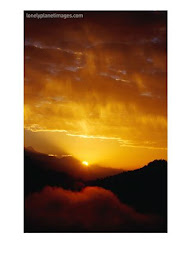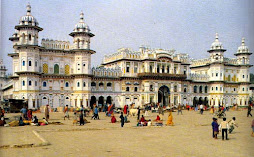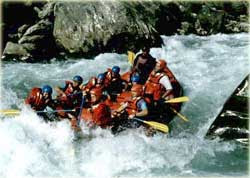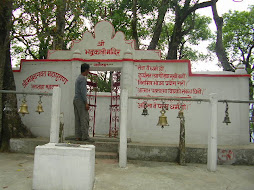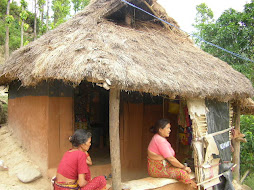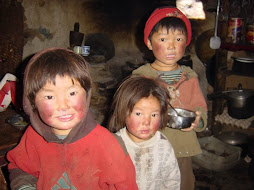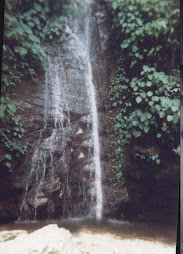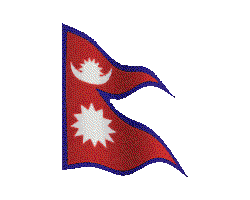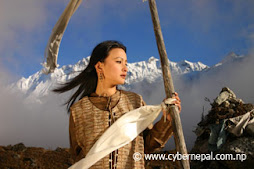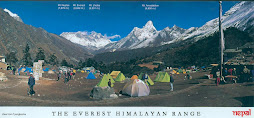

1. INTRODUCTION
1.1 Background of the Study
Tourism is a temporary movement of people to destinations outside their usual places of work and residence, the activities undertaken during their stay those destination and facilities created to cater their needs. Generally, tourism is the movement of people from one place to another place for the purpose of business pleasure and recreation but not less than 24 hour and not more than one year.
Globally, Tourism is the single largest industry in the world. It is one of the most dynamic and vibrant sector of the world economy. Tourism is becoming increasingly important socially, economically and environmentally as it continues to develop throughout the world. Today, more than two-third of employment and income generation in the industrialized countries is attributed not to industry or agriculture but to the service sector. The World Tourism Organization estimates that some 20% of the workers today are employed in tourism related service.
Tourism is among the top three industries in many countries. It is one of the fastest growing industries in the world. While a total of 25.3million international tourist arrivals were recorded in the year 1950, their volume has increases to 698.3 millions in 2000, which is over 27.5 fold increases over the period of fifty year. It is one of the most important industries in the world in terms of generating revenue and creating to employment opportunities and increases the national income of the country. According a 1992 study conducted by the WTTC, the tourism industry generates more than $2500 billion annually in gross revenue or 5.5% of the world economy. This industry also provides jobs for more than 112 million people or 1 of every 15 people of the world employees. Moreover, tourism contributes more than $300 million in direct, indirect and personal taxes each year, approximately 6% of world total payments in terms of total revenue, investment and employment, the tourism industry is the rapidly growing industry in the world. (Statistics of WTTC, 2000)
Nepal is one of the richest countries in the world in terms of bio-diversity due to the unique geographical position and latitudinal variation. The elevation of the country ranges from 70m above the sea level to the highest peak of the world, Mt. Everest at 8,848m with climatic condition ranging from sub tropical to arctic.
Nepal is traditionally a tourist country. Nepal possesses a depositary of places of widely historic interest. It is an ancient country with rich cultural heritage. An independent sovereign state, united by king Prithivi Narayan Shah, the great. Nepal lies in lap of the mighty Himalays. It is rich in varied landscapes, lakes, waterfalls, green valleys and terraces. The entire northern border is lined with silvery peaks of the Himalayas the most fascinating of which is Sagarmatha or Mount Everest- highest peak of the world.
Nepal is bordered by India in south and west, by sikkim and India to the east and by Tibet regions of the people’s of Republic of China in the north. The length of Nepal is 880km east to west and its breadth varies from 145 to 241 km. Nepal covers an area of 147,181 Sq. Km. and has a population of nearly 23 million. The culture of Nepal is made up of the blending of the two great Hindu and Buddhist religion. Traditionally folk’s songs and colorful festivals are well preserved all over the country.
Nepal offers exciting fascination owing to the vastness of natural panorama, the high standard of cultural achievements, the pleasant, coolness of its climate, the uniqueness of its flora and fauna. It features attractions ranging from magnificent alpine scenery to the highest Himalayan panorama. It is truly a bewitching land of contrasts, rugged mountain ranges, green and cool valleys, fertile and tropical forests, the rolling downs of the Terai, and the pristine glory of perpetual snows. (Satyal, 2001)
Nepal has many historically importance places which are equally rich in culture and natural beauty. Such places offers hold big potential for tourism development. Sindhuligadhi which lies in Sindhuli district is one such potential place. Geographically, Sindhuli occupied some part of Churiya and some part of Mahabharat and situated at inner part of Tarai and lies 26° 55’ to 27° 22’ northern latitude and 85° 15’ to 86 ° 25’ east longitudes. It occupied 1.69% total land of the country or occupied 2491 Sq km. The elevation of the district is 168m to 2787m. The climates are varying from place to place due to the altitudinal variation. This district also called second heavy rainy place in the country. The average rainfall is more than 296.12mm and average temperature is 15.58°c to 26.91°c in sunrise and 18.5°c to 27.3°c in sunset.
The major rivers are Bagmati, Kamala, Gwang, Gadauli, Marin, Kukurthakur, Bitijor, Arunthakur, Labda, Chadaha, Bandijor and Garduwa. Most of the lands are occupied by forest or 67.8% lands are occupied by forest. Sal, Chilaune, Jamuna are available in around Churiya and Sallo, Rhodondran, Painyu, Katush,Wallnut,Uttish etc. are available in around Mahabharat. The highest peak of the district is “Landrang Danda” which is located at Tinkanya VDC where we can see the beautiful view of Gaurishankar Himal and greenery forest.
The main tourism places are Sindhuligadhi, Hariharpurgadhi, Panchakanya pokhari, Ratanchura cave, Sarswoti jharana, Kasiram jharana, Baseswor cave, Sarpedhunga and kyneswor kunda and pilgrimage places are Siddababa Temple, Kalika Temple, Kusheswor Mahadev, Ptandevi Temple, Kamalmai Temple, Kalikhola Mahadev and Ganesh Thaan.
Most of the people depend on agriculture and main crops are Paddy, Wheat, Maize, Mustard, Millet etc. People also produce different kind of fruits like Junar, Orange, Pineapple, Mango etc. Sindhuli is famous for huge production of Junar fruits. Not only produce the fruits, they also produce vegetables, Coffee, Handicraft, Chhurpi, Herbal drugs etc
In this district, the people are Brahamn, Chhetri, Magar, Newar, Tamang, Damai, Kami, Sarki, Sunuwar, Sanyasi, Tharu, Rai, Limbu, etc. The ethnic groups are Danuwar and Maghi. The settlement of the Danuwar and Majhi are located at near side of Kamala River. According to 2001 census total number of population is 279930 in the Sindhuli district. The main language is Nepali and people have different religion, language and culture. Hindu people are 75%, Buddha people are 23% and other are2% in the Sindhuli district. . (DDC, 2056)
Sindhuligadhi is one of the historical and beautiful places which are situated northern part of Mahabharat belt of Sindhuli district and lies in Jalkanya VDC Wada no.1. Situated on the hilly area and between the forests, this Sindhuligadhi lies in 27º 28’ north latitude and 85 º 97’ east longitudes. The elevation of the Sindhuligadhi is 1417m above the sea level.
Environmentally, this place is good for recreation and pleasure. During the month of Magh and Fagun (Rhododendron forest looks like a flower garden and can also lure to people to stay more at this place. The place of Sindhuligadhi where visitors can explore the exotic view of beautiful mountain of Gourishankar, can see sunrise, valleys, landscape, green forest etc.
This place is that historical place where we found our nationalistic fervor first rose against disunity and invasion. The place Sindhuligadhi is an all inclusive spot of heroic deed and exemplary rise of nationalistic fervor of Gorkhalis. It has been rightly claimed what is there in Sindhuligadhi is rare to be found elsewhere in our country. It is an excellent saga of valor.
The most striking fact is that Sindhuligadhi is the place where engulfing the then British militaries were first vanquished in Asia continent. Now where had they retreated and being trounced so mortifyingly except in Sindhuligadhi of Nepal. Therefore Sindhuligadhi is the place of Asia continent where British solders were beaten first. Their defeat and retreat made nasty slam to British Governor and they were forced to think about their own military capability as well as warfare and Gorkhas and their bravery. It is said that the Gorkhas has been in top priority in military recruitment under the Union jack since then.
A journey to Sindhuligadhi gives great pleasure to travelers. The delight of travel won’t be forgettable. Serpentine course of pitched road slithers away over your head. Tremendous ascend of the hill in series of zigzag is really fantastic. It dominates all the road of Nepal in its bending and twisting course. When ascend ends, Aadh alias pouagadhi comes on the way. The road rounds the forte. Immidiately splendid glittering of the Gaurishankar Himal appears in the far convex horizon. Submissive, gesture of goddess Parvati before the god Shankar can amazingly witnessed virtually at stones throw distance. Panoramic view of Mahabharat range and Ramechap district and high-rise frozen leks are really impressive. (Jyotipunja Smarika, 2062)
Sindhuligadhi has an immense potential of tourism in Nepal. Under construction BP hiighway touches this place in around 95km from Dhulikhel and 58km from Mahendra highway. It will be easily accessible historical place of Nepal after the completion of BP highway.
Tourism has contributed role for economic development of the country as well as increases the per capita income of the local people and also increases the national income of the country. It contributes to increase the GDP of the country and it will help for national development. Sustainable tourism not only contributes for economic development but it is also concerned with conservation of natural and cultural heritage.
Tourism is an up growing industry in Nepal. Tourism helps generate more revenue for country and its people. Kathmandu, Pokhara, Chitwan, Lumbini and Khumbu region played an important role for development of tourism. These are the major tourist destinations. These places are famous for various aspects as for e.g. Chitwan is famous for nature paradise and jungle safari and Khumbu region is famous for trekking and mountaineering expedition. This is not enough for the development of tourism but there are many places in Nepal which has not been developed yet. Among such places, Sindhuligadhi also can be a major tourist destination in terms of its ancient history, cultural and nature heritage sites. The important aspect of Sindhuligadhi that it has rich flora with varieties in itself as for e.g. Rhododandran, Katus, Kafal, Nilkamal, Sunakhari etc.. During winter season, one can experience or feel the consoling cool climate with fog that can vanish people in seconds. Thus, this study is carried out to explore the potentialities of tourism development in Sindhuligadhi.
1.2 Objective of the study
The broader objective is to study the Potential of Tourism Development in Sindhuligadhi. The specific of the study are:
1. To collect information regarding natural and cultural resources of Sindhuligadhi.
2. To identify state of existing infrastructure of Sindhuligadhi that is required for tourism development and suggest improvement required there in.
3. To identify the state of accommodation catering facilities and other tourist related facilities in Sindhuligadhi.
4. To suggest various measures for development and promotion of tourism in Sindhuligadhi.
1.3 Methodology of the study
A. Research Design
This study is based on descriptive research design. The study has also attempted to find out the perception of local people about tourism in Sindhuligadhi.
B. Sampling Design
Study cannot be reach to each and everyone who related to the problem of study so, small portion and analysis from which conclusion can be drawn. For the purpose of this study 20 locals were selected through random sampling to study the perception of locals.
C. Nature and Sources of Data
This study is based on primary as well as secondary information. The primary information is collected through field survey, i.e. questionnaire survey, and interview method. Similarly, the secondary data is collected from tourism related organization, publications, published and unpublished paper, articles of the newspaper and websites etc.
D. Data Analysis
The information and data collected is properly categorized, tabulated and summarized as per the requirement. For the purpose of data analysis simple statistical tools such as percentage, average, growth rate etc. is used. The results are presented with the help of tables, charts, pie charts, bar graphs etc.
1.4 Assumptions and Limitations
While conducting the study on Potentiality of Tourism Development in Sindhuligadhi. Some limitations were encountered. The limitations of the present study are:
Ø There was a basic problem with data and information. Requisite information is not easily available.
Ø Inadequate availability of secondary sources of information and literature relevant to the topic was another big limitation.
Ø This study was conducted in short time period and small budget at researcher at own expenses.
Ø The limited time available for the study was another major constraint.
2. SINDHULIGADHI: A DESTINATION PROFILE
2.1 Geographic Location, Physical Feature and Climate
Sindhuli lies in Janakpur Zone in the Middle development Region of Nepal. Sindhuli district has an area of 2491sq km which represents 1.69% of the total land area of the country. Geographically, this district lies between 26° 55’ to 27° 22’ north latitude and 85° 15’ to 86°25’ east longitude. The elevation of the district ranges from 305m to 2787m therefore climatic condition varies from place to place due to the altitude variation. This district is also known for being the second heavy rainy place in the country. The average rainfall is more than 296.12mm and average temperature is 15.58°c to 26.91°c in sunrise and 18.5°c to 27.3°c in sunset. The major rivers are the Bagmati, Kamala,Arunthakur, Gwang Khola, Bitijor, Chandaha, Marin Khola etc.
It is bounded on the north by Kavrepalanchok and Ramechhap districts, on the south by Sarlahi, Routhat, Dhanusa and Mahottari districts, on the east by Udayapur and Okhaldhunga districts and on the west by Makwanpur and Kavrepalanchok districts.
Sindhuligadhi, the area of the study is located in Jalkanya VDC Wada no. 1 of Sindhuli district. Geographically, it lies between 27° 28’ north latitude and 85° 97’ east longitude. The elevation of the Sindhuligadhi is 1417m above the sea level. The average temperature of this place is the 5°c to 22°c. This beautiful and historical place is situated on the Mahabharat belt. Sindhuligadhi is rich in flora with varieties in itself as for e.g. Rhododandran, Katus, Kafal, Nilkamal, Sunakhari etc. Tourist can enjoy scenic attraction like Himalays(Gaurishankar Himal and Others), Landscapes, Green Forest, Valleys, Gadhi etc. During winter season, one can experience or feel the consoling cool climate with fog that can vanish people in seconds.
2.2 Accessibility
Sindhuligadhi is easily accessed by road. This place is 58 km far from Mahendra Highway and the nearest airport is Janakpur Airport which is approximately 70 km far from Sindhuligadhi, visitors can fly from Kathmandu to Janakpur and then continue their journey by road. Under construction BP Highway touches this place in around 95km from Dhulikhel. It will be easily accessible historical place of Nepal after the completion of BP highway.
2.3 Demographic Features
According to 2001 Census the total number of Population of the Sindhuli districts is 279821. Among these number of Households, Population in the Household by Sex, Area and Population Density are given in the table:
Population 2001
Number of Households
Average
Household Size
Area in
Sq Km
Population
Density
Number
Percentage
Total
Total
Male
Female
279821
13928
140501
1.21
48758
5.74
2491
112
Table1 Source: Nepal District Profile, 2006
Households having Agricultural Land, Livestock and Poultry
Agricultue Land Only
Livestock Only
Poultry only
Land Livestock
Land
& Poultry
Livestock
& Poultry
Land Livestock& Poultry
None Of All
Total
2220
429
122
6141
611
820
34469
2398
47710
Table 2 Source: Nepal District Profile, 2006
Population by Religion
Hindu
Buddha
Islam
Kirat
Jain
Christian
Sikh
Bahai
Others
Total
199098
77892
132
5937
6
548
41
2
2602
277259
Table 3 Source: Nepal District Profile, 2006
Population by different Caste of Sindhuli District
S.N.
Caste
According To 2048 Census
According To 2058 Census
%Total
Of 2058
Male
Female
Total
Male
Female
Total
1.
Bahun
12135
12086
24229
16321
15156
31477
11.24%
2.
Chhetri
16877
17440
34317
21892
21819
43711
15.61%
3.
Newar
7274
7239
14505
8356
9850
18206
6.50%
4.
Tamang
27391
27464
55255
34706
34276
68982
24.65%
5.
Rai/Gurung
2395
2439
4834
2785
2955
5740
2.05%
6.
Magar
15797
16015
31812
19499
19980
39479
13.39%
7.
Danuwar
4926
5080
10006
5571
6331
11902
4.26%
8.
Majhi
3824
3988
7892
4735
4925
9660
3.45%
9.
Sunuwar
3325
3369
6694
4039
4180
8219
2.93%
10.
Tharu
530
554
1084
557
563
1120
0.40%
11.
Masahar
680
654
1334
935
803
1738
0.62%
12.
OtherTarians
1257
1097
2354
1632
1365
2997
1.08%
13.
Sanyasi
743
723
1466
838
880
1718
0.61%
14.
Damai
3230
3261
6491
3900
4280
8180
2.93%
15.
Kami
5037
4890
9927
6228
6050
12278
4.37%
16.
Sarki
3547
3444
6991
4318
4421
8739
3.12%
17
Other
2441
2356
4797
2970
2814
5784
2.07%
Total
111409
112491
223900
139282
140648
279930
100%
Table 4 Source: Jilla Parsochitra Sindhuli
Sindhuligadhi lies in Jalkanya VDC and the total no of population of this VDC is 1923 according to 2058 Census but in 2048 Census it was the 1955.The male and female populations in the Jalkanya in table below.
According To 2048 Census
According To 2058 Census
No. of Houses
322
348
Male
955
912
Female
1000
1011
Total
1955
1923
Growth no.
-32
Growth %
-1.67%
Table 5 Source: Jilla Parsochitra Sindhuli
In Jalkanya VDC the statistics of the older persons, Disable persons, Intolerable persons and Death persons is given in the table below:
According To 2057 B.S.
According To 2058 B.S.
Older Persons
29
32
Widow/Intolerable Persons
21
22
Disable Persons
2
2
Death No. Due to Coincident
0
0
Table 6 Source: Jilla Parsochitra Sindhuli
2.4 Historical Background of Sindhuligadhi
Nepal and India have good relation since the ancient time. Different sources proved that Indian business people and religious people frequently travel via the Sindhuligadhi. In that time, Sindhuligadhi was the main entrance of the eastern side to enter Kathmandu. The huge gadhi proved that, it was the main easy way to enter Kathmandu. According to inscription of 1738 B.S. of the pillar of the Taleju Temple, it was the Gadhi before the period of Partivendra Malla. In this inscription, Parthivendra Malla won the Sindhuli with the help of powerful armies but he found it difficult to win the Sindhuligadhi. Therefore this place was the strong killa during that period.
According to different sources, Sindhuligadhi was under Senbansi kings during the period of Middle time (Madhyakal) and Gadhi lies under the Makawanpur Kingdom. In 1620B.S, Lohang Sen built the gadhi and he was the son of the Manikya Sen, who was the king of Makawanpur. Manikya Sen also rebuilt the Sindhuligadhi and he joined in Thakurai of Makwanpur to settlement of Khash Magar which lies in northern part of Mahabharat or near of the Sunkoshi River.
Since 1800B.S. Prithivi Narayan Shah started the unification of Nepal. During the unification period, he felt the need of help of Makawanpur and he married with Indrakumari, the daughter of the Hemkarna who was the king of Makawanpur State. To win Malla State of the Kathmandu valley, he took action strike against Malla state of Kathmandu. In that time Makwanpur was mostly important for business in Southern part and this state is needed to win for Kathmandu Valley by Prithivi Narayan Shah. He fulfilled his dream in 1819B.S. with the help of three brothers. When Gorkhalis won the Makawanpur State and its King Digbandha Sen went to stay at Hariharpurgadhi as a refugee. But Gorkhalis captured the Hariharpurgadhi and then Digbandha Sen surrendered to Gorkhali and Gorkhali also won the Sindhuligadhi in 1819B.S. During that period Prithivi Narayan Shah protected Sindhuligadhi and he built the small Gadhi which is called ‘Pouagadhi’ and it is situated in lower part of the Sindhuligadhi.
Sindhuligadhi is that place where Gorkhalis defeated the British militaries in 1824B.S. In that time Jaya Prakash Malla asked East India Company to save his Kathmandu kingdom and British accepted to help and sent 2400 armies under the Captain Kinlock. They tried to enter the Kathmandu via Sindhuligadhi. But Gorkhalis attacked to British militaries in Sindhuligadhi with the help of 1200 militaries with the help of simple guns but they also attacked by Wood, Stone, Khukuri Allo, Sisno(hot plant),Ghuyatro, Insects(Bee, Barula, Bachhyou) etc. In that time these hot plants and harmful insects were used as a weapon by the Gorkhalis. British armies were also not familiar with these harmful plants and insects. They said “Plants and Insects are also our satru”. They also created scarcity of water, food on the way to British Militaries and defeated the British armies and captured 2 Cannons, 300 Guns and other weapons. Captain Kinlock returned back with 800 armies and lost the 1600 armies at Sindhuligadhi. So victory again went to the Gorkhas.
During the period of Rana Regime, Karnel Puskar Bikram Rana lived with 200 armies in Sindhuligadhi in1975B.S. In that time he built Chautara, Party, Poua etc. During the time of Panchyatkal it was the district headquarters of the Sindhuli district and all government office was also located here. Later it was transferred in the Sindhulimadhi.
A. Suntalimai and Sindhuligadhi
“Sindhuligadhi ghumer herda Suntalimai kati na ramro darbar
maryo ni mayale maryo
Bainsa ma lahur gaya pani Suntali mai aauchhu mata pharker maryo maryo ni
mayale maryo”......
It is difficult to find out any Nepali who has not listened above lines and this song help to recognize the Sinhuligadhi in Nepal as a national heritage. This song is sung and written by Krisna Bikram Thapa who has been living in Sindhuli. In this song writer explain about the Suntalimai and Sindhuligadhi Darbar. Suntalimai was the unmarried old woman of Hayu caste and she served to Ranas , she helped to clean the palace during the period of Rana Regime. At that time Badahakim Chhabindra Bikram Rana ruled over Sindhuligadhi later he killed himself by pistol in the security house where Suntalimai lived. Therefore this song helped to remember the Sindhuligadhi at one time. But unfortunately he died May 2008.
2.5 Socio Culture and Economic Background
In around Sindhuligadhi, the economy is largely based on agriculture. It is also the major source of livelihood for the local people in Jalkanya VDC and it is backbone of economy of the local people. The people produce different types of grains like Paddy, Maize, Millet, Mustuard and Vegetables. Most of the land is not plain and not suitable for growing food grains crops. But its agro-climatic condition and geographical location is favorable for growing a variety of fruit species like Junar, Lemon, Orange, Nibuwa etc. This place is famous for Junar production. Junar farming is connected with economic rise of the local people.
People are not only involve in the agriculture, they also worked at different offices, some people are involve in different business and some people are work for near under construction BP Highway which gives the employment opportunities for the local people in and around Sindhuligadhi.
Mainly, Brahmin, Chhetri, Magar, Newar, Tamang, Rai and Gurung people have been living in and around Sindhuligadhi. They have different customs, tradition and their culture. Brahmin,Chhetri people follow the Hinduism and Tamang, Gurung, Magar people follow the Buddhism and Newar people also follow the Hinduism. Their rituals are also different one to another like marriage system, Birth Ceremony, Name giving Ceremony and Funeral Rites.
2.6 Major Attraction of the Sindhuligadhi
A. Natural Attractions
Sindhuligadhi is that beautiful place which gives more pleasure to travelers and gives more recreation to the visitors. The sightseeing view of the green forest and Mahabharat range lure visitors to stay at Sindhuligadhi. The climate of the Sindhuligadhi is always cool and cold which attract to the visitors and makes the peaceful environment. During the month of Magh, Fagun(Jan-Feb) the Rhododendron forest looks like flower-garden. It is rich in flora with varieties in itself as for e.g. Rhododendron, Katus, Kafal, Nilkamal, Sunakhari etc. During winter season, tourist can experience or feel the consoling cool climate with fog that can vanish people in seconds.
The splendid glittering of the Gaurishankar Himal appears in the far convex horizon. Submissive, gesture of goddess Parvati before the god Shankar can amazingly be witnessed virtually at stones throw distance. Panoramic view of Mahabharat range and Ramechap district and high-rise frozen leks are really impressive. It is also famous for as a Picnic Spot and hill station at Sindhuli.
B.Man Made Attractions
Sindhuligadhi is not only rich in nature itself there are also other attractions which help to gain the more knowledge about the Sindhuligadhi. Sindhuligadhi is rich in culture heritage. This historical place is famous for ancient history of the Prithivi Narayan Shah. Also this place is connected with the Unification Period of the new Nepal. Sindhulighadhi is that place where Gorkhalis defeat the British armies. Apart from the legend the historical religious and cultural attractions of the region are:
1. Rani Durbar
Situated at an altitude 1417m, Rani Darbar lies in Mahabharat belt. This historic palace situated 23km north from Sindhulimadhi can be reached by public transport. Built by Bambir Bikram Bahadur Rana, the palace is one of the most beautiful and artistic. This Palace was built in 1956 B.S. Among the brick walls in their gracious setting and sculpture design shows the glorious history of the Rana Regime. The maximum length of the palace is 104’ and maximum breadth is 48’-4” and the roof is covered by Tins. But today it is getting destroyed due to the lack of conservation efforts.
2. Siddababa Temple (Gadhi)
The Siddababa Temple situated 800m east from Ranidurbar and it was built in 300 years ago. The temple has richly carved bells which were offered by the devotees in 1982 B.S, 1977 B.S, 1961 B.S and 1943 B.S. This one storied pagoda temple is the sign of God Shiva. During the festival of Teej women gathers and worship the God Shiva. This is one of the most colorful days of the year of the women and they sing songs with bright red wedding saris. Therefore this temple is famous for Teej festival especially for women.
3. Siddababa Temple (Chayoukot)
This temple is situated in the hilly side of Sindhulimadhi and lies in Chayoukot. A hike of 1.5 hour takes one to this place where visitors can see the beautiful landscapes and valley. This temple is also the sign of God Shiva and also the Kul Devata of the Adhikari People. The temple is just renovated with the help of local people and Shrestha Construction Company. This temple is famous for Mansire Purnima and Baisakh Purnima. In this time many devotees were gathered and worship for the god and distribute the rota as a parsadi. The specialty of this temple is that red tikka and red flowers are not necessary for worship. Only yellow colour is offered to God by the devotees. Devotees also gather here during the festival of Shivaratri. There is also legend of this temple, One Adhikari Brahmin got the success in his meditation and he became supernatural powerful man of this region. People also believe that because of this Sidda place and the Brahmin, this place got its name Sindhuli.
4. Pouagadhi (Aadh)
Pouagadhi situated on the way to BP Highway is 3 km far from Ranidurbar. Local people also called it Aadh. Pouagadhi is that historic place where Gorkhalis defeated the British armies. It is also connected with the history of Unification of the Nepal and it was built by king Prithivi Narayan Shah. This beautiful artistic place is just renovated by local people and Shrestha Construction Company. It is made of stones where Gorkhalis kept their weapon in Pouagadhi in Unification period and the armies used to protect the state from here. The huge door shows the history of the Prithivi Narayan Shah.
5. Bhadrakali Temple
Bhadrakali Temple situated on the way to BP Highways lies 3 km far from Pouagadhi. This temple is the sign of Goddess Kali. During the Dashain festival many people came to worship to the goddess kali and some people sacrifice the animals some people offer Coconut and flowers. This temple is also known as the sister of the Manakamana of the Gorkha. According to inscription carved in bell in 1946 B.S., it was proved that this temple was built 100 years ago. The specialty of this temple is that it has no roof.
6. Ganesh Thaan
Ganesh Thaan situated approximately 5 km far from Sindhuligadhi. This temple is the sign of God Ganesh. Many people came for worship for God on every Tuesday. This temple is famous in Sindhulimadhi. The other attraction of the temple is the water falls which are located near the temple.
7. Kalika Temple
This temple is situated 1 km far from Sindhulimadhi and lies under the Kamalamai Municipality -4, Madhutar. It is said to be built in 200 years ago. This temple is the sign of Goddess Kali. Many devotees gather here during the time of Dashain, Maghe Sankranti and Sahune Sankranti. At that time devotees sacrifices the Goat, Chickens, Pigeon and Other animals. The 7th day of Dashain( Phoolpati), District Police Officers sacrifice the goat and salute by gunfire. At the time of Maghesankranti Dhami people gather here and performed their dance with their musical instrument and customs.
8. Kashiram Falls
Kashiram falls situated in the Kamlamai Municipality-9, Dhovantar is 4 km far from Sindhulimadhi and also lies on the way of Siddababa Temple in Chayoukot. People can walk 15 minute from the bus station of the BP Highway. This beautiful water falls is very attractive but due to the lack of promotion and conservation it is getting shadowed.
9. Bagwani Farm
This Bagwani farm is situated near the Kalika Temple and 500m far from Sindhulimadhi. The visitors can explore the different agricultural products and can also study the germination, plantation, and nursery of the different plants. This farm also produces the different vegetables and fruits like Lichhi, Mango, and Pineapple etc. This farm is suitable for the agriculture students to gain knowledge about the agriculture and one can see the green view of the different plants and vegetables
10. Balan Dance
This dance is performed as a means of rituals performance uttering the name of Lord. There is no specific time to celebrate this dance but in special occasion it is celebrated. Though the origin of this dance is Sindhuli but it is also performed in other places of Nepal.
This dance is mainly organized for group worship, where devotees perform by dancing and singing the name of glory of lord Rama and others whole night. There is a one-group leader who will be assisted and followed by rest of the people and two dancers perform dances. The participants also play different musical instrument. The main objective of this dance is to gain God’s bliss and to extend brother-hood among each other.
11. Kamala Mai Temple
Situated on the confluence of the Gwang Khola and Kamla River, this temple is approximately 10 km far from Sindhulimadhi and lies on the way to BP Highway. It is said to be renovated in 2041B.S. But according to the carved statue of lion, in 1972 B.S. and as per copper inscription in 1974 B.S., it might be oldest temple in Sindhuli. This two-storied pagoda temple is the sign of Goddess Durga. Many devotees gathered here at the time of Dashain, Maghesankranti and Sahune Sankranti and sacrifice the Goat, Chicken and other animals. Devotees also come here from the India and different parts of Tarai of Nepal during Maghesankranti. This temple is famous for Maghesankranti where many devotees came and celebrate the Mela at the day of Masanta. At the time of Mela people gather and sing songs and perform dance whole night. People also sell the local goods at the Mela and also come from very far away places to celebrate the Mai Mela.
2.7 Facilities and Amenities
1. Accommodation
There are not sufficient accommodation facilities for the tourist at Sindhuligadhi. Two tea shops are available in Solabhyanjhyang near the Sindhuligadhi and it can provided tea and breakfast for the visitors. But 20 km drive to Sindhulimadhi; there are three hotels which gives the general facilities to the tourists. These hotels are:
1. Siddababa Guest House
2. Hotel Anupam
3. Himshikhar Guest House
2. Electricity
There is sufficient electricity available in and around Sindhuligadhi which is being used by the local peoples. The Nepal Electricity Corporation has been providing electricity in around the villages of Sindhuligadhi.
1.1 Background of the Study
Tourism is a temporary movement of people to destinations outside their usual places of work and residence, the activities undertaken during their stay those destination and facilities created to cater their needs. Generally, tourism is the movement of people from one place to another place for the purpose of business pleasure and recreation but not less than 24 hour and not more than one year.
Globally, Tourism is the single largest industry in the world. It is one of the most dynamic and vibrant sector of the world economy. Tourism is becoming increasingly important socially, economically and environmentally as it continues to develop throughout the world. Today, more than two-third of employment and income generation in the industrialized countries is attributed not to industry or agriculture but to the service sector. The World Tourism Organization estimates that some 20% of the workers today are employed in tourism related service.
Tourism is among the top three industries in many countries. It is one of the fastest growing industries in the world. While a total of 25.3million international tourist arrivals were recorded in the year 1950, their volume has increases to 698.3 millions in 2000, which is over 27.5 fold increases over the period of fifty year. It is one of the most important industries in the world in terms of generating revenue and creating to employment opportunities and increases the national income of the country. According a 1992 study conducted by the WTTC, the tourism industry generates more than $2500 billion annually in gross revenue or 5.5% of the world economy. This industry also provides jobs for more than 112 million people or 1 of every 15 people of the world employees. Moreover, tourism contributes more than $300 million in direct, indirect and personal taxes each year, approximately 6% of world total payments in terms of total revenue, investment and employment, the tourism industry is the rapidly growing industry in the world. (Statistics of WTTC, 2000)
Nepal is one of the richest countries in the world in terms of bio-diversity due to the unique geographical position and latitudinal variation. The elevation of the country ranges from 70m above the sea level to the highest peak of the world, Mt. Everest at 8,848m with climatic condition ranging from sub tropical to arctic.
Nepal is traditionally a tourist country. Nepal possesses a depositary of places of widely historic interest. It is an ancient country with rich cultural heritage. An independent sovereign state, united by king Prithivi Narayan Shah, the great. Nepal lies in lap of the mighty Himalays. It is rich in varied landscapes, lakes, waterfalls, green valleys and terraces. The entire northern border is lined with silvery peaks of the Himalayas the most fascinating of which is Sagarmatha or Mount Everest- highest peak of the world.
Nepal is bordered by India in south and west, by sikkim and India to the east and by Tibet regions of the people’s of Republic of China in the north. The length of Nepal is 880km east to west and its breadth varies from 145 to 241 km. Nepal covers an area of 147,181 Sq. Km. and has a population of nearly 23 million. The culture of Nepal is made up of the blending of the two great Hindu and Buddhist religion. Traditionally folk’s songs and colorful festivals are well preserved all over the country.
Nepal offers exciting fascination owing to the vastness of natural panorama, the high standard of cultural achievements, the pleasant, coolness of its climate, the uniqueness of its flora and fauna. It features attractions ranging from magnificent alpine scenery to the highest Himalayan panorama. It is truly a bewitching land of contrasts, rugged mountain ranges, green and cool valleys, fertile and tropical forests, the rolling downs of the Terai, and the pristine glory of perpetual snows. (Satyal, 2001)
Nepal has many historically importance places which are equally rich in culture and natural beauty. Such places offers hold big potential for tourism development. Sindhuligadhi which lies in Sindhuli district is one such potential place. Geographically, Sindhuli occupied some part of Churiya and some part of Mahabharat and situated at inner part of Tarai and lies 26° 55’ to 27° 22’ northern latitude and 85° 15’ to 86 ° 25’ east longitudes. It occupied 1.69% total land of the country or occupied 2491 Sq km. The elevation of the district is 168m to 2787m. The climates are varying from place to place due to the altitudinal variation. This district also called second heavy rainy place in the country. The average rainfall is more than 296.12mm and average temperature is 15.58°c to 26.91°c in sunrise and 18.5°c to 27.3°c in sunset.
The major rivers are Bagmati, Kamala, Gwang, Gadauli, Marin, Kukurthakur, Bitijor, Arunthakur, Labda, Chadaha, Bandijor and Garduwa. Most of the lands are occupied by forest or 67.8% lands are occupied by forest. Sal, Chilaune, Jamuna are available in around Churiya and Sallo, Rhodondran, Painyu, Katush,Wallnut,Uttish etc. are available in around Mahabharat. The highest peak of the district is “Landrang Danda” which is located at Tinkanya VDC where we can see the beautiful view of Gaurishankar Himal and greenery forest.
The main tourism places are Sindhuligadhi, Hariharpurgadhi, Panchakanya pokhari, Ratanchura cave, Sarswoti jharana, Kasiram jharana, Baseswor cave, Sarpedhunga and kyneswor kunda and pilgrimage places are Siddababa Temple, Kalika Temple, Kusheswor Mahadev, Ptandevi Temple, Kamalmai Temple, Kalikhola Mahadev and Ganesh Thaan.
Most of the people depend on agriculture and main crops are Paddy, Wheat, Maize, Mustard, Millet etc. People also produce different kind of fruits like Junar, Orange, Pineapple, Mango etc. Sindhuli is famous for huge production of Junar fruits. Not only produce the fruits, they also produce vegetables, Coffee, Handicraft, Chhurpi, Herbal drugs etc
In this district, the people are Brahamn, Chhetri, Magar, Newar, Tamang, Damai, Kami, Sarki, Sunuwar, Sanyasi, Tharu, Rai, Limbu, etc. The ethnic groups are Danuwar and Maghi. The settlement of the Danuwar and Majhi are located at near side of Kamala River. According to 2001 census total number of population is 279930 in the Sindhuli district. The main language is Nepali and people have different religion, language and culture. Hindu people are 75%, Buddha people are 23% and other are2% in the Sindhuli district. . (DDC, 2056)
Sindhuligadhi is one of the historical and beautiful places which are situated northern part of Mahabharat belt of Sindhuli district and lies in Jalkanya VDC Wada no.1. Situated on the hilly area and between the forests, this Sindhuligadhi lies in 27º 28’ north latitude and 85 º 97’ east longitudes. The elevation of the Sindhuligadhi is 1417m above the sea level.
Environmentally, this place is good for recreation and pleasure. During the month of Magh and Fagun (Rhododendron forest looks like a flower garden and can also lure to people to stay more at this place. The place of Sindhuligadhi where visitors can explore the exotic view of beautiful mountain of Gourishankar, can see sunrise, valleys, landscape, green forest etc.
This place is that historical place where we found our nationalistic fervor first rose against disunity and invasion. The place Sindhuligadhi is an all inclusive spot of heroic deed and exemplary rise of nationalistic fervor of Gorkhalis. It has been rightly claimed what is there in Sindhuligadhi is rare to be found elsewhere in our country. It is an excellent saga of valor.
The most striking fact is that Sindhuligadhi is the place where engulfing the then British militaries were first vanquished in Asia continent. Now where had they retreated and being trounced so mortifyingly except in Sindhuligadhi of Nepal. Therefore Sindhuligadhi is the place of Asia continent where British solders were beaten first. Their defeat and retreat made nasty slam to British Governor and they were forced to think about their own military capability as well as warfare and Gorkhas and their bravery. It is said that the Gorkhas has been in top priority in military recruitment under the Union jack since then.
A journey to Sindhuligadhi gives great pleasure to travelers. The delight of travel won’t be forgettable. Serpentine course of pitched road slithers away over your head. Tremendous ascend of the hill in series of zigzag is really fantastic. It dominates all the road of Nepal in its bending and twisting course. When ascend ends, Aadh alias pouagadhi comes on the way. The road rounds the forte. Immidiately splendid glittering of the Gaurishankar Himal appears in the far convex horizon. Submissive, gesture of goddess Parvati before the god Shankar can amazingly witnessed virtually at stones throw distance. Panoramic view of Mahabharat range and Ramechap district and high-rise frozen leks are really impressive. (Jyotipunja Smarika, 2062)
Sindhuligadhi has an immense potential of tourism in Nepal. Under construction BP hiighway touches this place in around 95km from Dhulikhel and 58km from Mahendra highway. It will be easily accessible historical place of Nepal after the completion of BP highway.
Tourism has contributed role for economic development of the country as well as increases the per capita income of the local people and also increases the national income of the country. It contributes to increase the GDP of the country and it will help for national development. Sustainable tourism not only contributes for economic development but it is also concerned with conservation of natural and cultural heritage.
Tourism is an up growing industry in Nepal. Tourism helps generate more revenue for country and its people. Kathmandu, Pokhara, Chitwan, Lumbini and Khumbu region played an important role for development of tourism. These are the major tourist destinations. These places are famous for various aspects as for e.g. Chitwan is famous for nature paradise and jungle safari and Khumbu region is famous for trekking and mountaineering expedition. This is not enough for the development of tourism but there are many places in Nepal which has not been developed yet. Among such places, Sindhuligadhi also can be a major tourist destination in terms of its ancient history, cultural and nature heritage sites. The important aspect of Sindhuligadhi that it has rich flora with varieties in itself as for e.g. Rhododandran, Katus, Kafal, Nilkamal, Sunakhari etc.. During winter season, one can experience or feel the consoling cool climate with fog that can vanish people in seconds. Thus, this study is carried out to explore the potentialities of tourism development in Sindhuligadhi.
1.2 Objective of the study
The broader objective is to study the Potential of Tourism Development in Sindhuligadhi. The specific of the study are:
1. To collect information regarding natural and cultural resources of Sindhuligadhi.
2. To identify state of existing infrastructure of Sindhuligadhi that is required for tourism development and suggest improvement required there in.
3. To identify the state of accommodation catering facilities and other tourist related facilities in Sindhuligadhi.
4. To suggest various measures for development and promotion of tourism in Sindhuligadhi.
1.3 Methodology of the study
A. Research Design
This study is based on descriptive research design. The study has also attempted to find out the perception of local people about tourism in Sindhuligadhi.
B. Sampling Design
Study cannot be reach to each and everyone who related to the problem of study so, small portion and analysis from which conclusion can be drawn. For the purpose of this study 20 locals were selected through random sampling to study the perception of locals.
C. Nature and Sources of Data
This study is based on primary as well as secondary information. The primary information is collected through field survey, i.e. questionnaire survey, and interview method. Similarly, the secondary data is collected from tourism related organization, publications, published and unpublished paper, articles of the newspaper and websites etc.
D. Data Analysis
The information and data collected is properly categorized, tabulated and summarized as per the requirement. For the purpose of data analysis simple statistical tools such as percentage, average, growth rate etc. is used. The results are presented with the help of tables, charts, pie charts, bar graphs etc.
1.4 Assumptions and Limitations
While conducting the study on Potentiality of Tourism Development in Sindhuligadhi. Some limitations were encountered. The limitations of the present study are:
Ø There was a basic problem with data and information. Requisite information is not easily available.
Ø Inadequate availability of secondary sources of information and literature relevant to the topic was another big limitation.
Ø This study was conducted in short time period and small budget at researcher at own expenses.
Ø The limited time available for the study was another major constraint.
2. SINDHULIGADHI: A DESTINATION PROFILE
2.1 Geographic Location, Physical Feature and Climate
Sindhuli lies in Janakpur Zone in the Middle development Region of Nepal. Sindhuli district has an area of 2491sq km which represents 1.69% of the total land area of the country. Geographically, this district lies between 26° 55’ to 27° 22’ north latitude and 85° 15’ to 86°25’ east longitude. The elevation of the district ranges from 305m to 2787m therefore climatic condition varies from place to place due to the altitude variation. This district is also known for being the second heavy rainy place in the country. The average rainfall is more than 296.12mm and average temperature is 15.58°c to 26.91°c in sunrise and 18.5°c to 27.3°c in sunset. The major rivers are the Bagmati, Kamala,Arunthakur, Gwang Khola, Bitijor, Chandaha, Marin Khola etc.
It is bounded on the north by Kavrepalanchok and Ramechhap districts, on the south by Sarlahi, Routhat, Dhanusa and Mahottari districts, on the east by Udayapur and Okhaldhunga districts and on the west by Makwanpur and Kavrepalanchok districts.
Sindhuligadhi, the area of the study is located in Jalkanya VDC Wada no. 1 of Sindhuli district. Geographically, it lies between 27° 28’ north latitude and 85° 97’ east longitude. The elevation of the Sindhuligadhi is 1417m above the sea level. The average temperature of this place is the 5°c to 22°c. This beautiful and historical place is situated on the Mahabharat belt. Sindhuligadhi is rich in flora with varieties in itself as for e.g. Rhododandran, Katus, Kafal, Nilkamal, Sunakhari etc. Tourist can enjoy scenic attraction like Himalays(Gaurishankar Himal and Others), Landscapes, Green Forest, Valleys, Gadhi etc. During winter season, one can experience or feel the consoling cool climate with fog that can vanish people in seconds.
2.2 Accessibility
Sindhuligadhi is easily accessed by road. This place is 58 km far from Mahendra Highway and the nearest airport is Janakpur Airport which is approximately 70 km far from Sindhuligadhi, visitors can fly from Kathmandu to Janakpur and then continue their journey by road. Under construction BP Highway touches this place in around 95km from Dhulikhel. It will be easily accessible historical place of Nepal after the completion of BP highway.
2.3 Demographic Features
According to 2001 Census the total number of Population of the Sindhuli districts is 279821. Among these number of Households, Population in the Household by Sex, Area and Population Density are given in the table:
Population 2001
Number of Households
Average
Household Size
Area in
Sq Km
Population
Density
Number
Percentage
Total
Total
Male
Female
279821
13928
140501
1.21
48758
5.74
2491
112
Table1 Source: Nepal District Profile, 2006
Households having Agricultural Land, Livestock and Poultry
Agricultue Land Only
Livestock Only
Poultry only
Land Livestock
Land
& Poultry
Livestock
& Poultry
Land Livestock& Poultry
None Of All
Total
2220
429
122
6141
611
820
34469
2398
47710
Table 2 Source: Nepal District Profile, 2006
Population by Religion
Hindu
Buddha
Islam
Kirat
Jain
Christian
Sikh
Bahai
Others
Total
199098
77892
132
5937
6
548
41
2
2602
277259
Table 3 Source: Nepal District Profile, 2006
Population by different Caste of Sindhuli District
S.N.
Caste
According To 2048 Census
According To 2058 Census
%Total
Of 2058
Male
Female
Total
Male
Female
Total
1.
Bahun
12135
12086
24229
16321
15156
31477
11.24%
2.
Chhetri
16877
17440
34317
21892
21819
43711
15.61%
3.
Newar
7274
7239
14505
8356
9850
18206
6.50%
4.
Tamang
27391
27464
55255
34706
34276
68982
24.65%
5.
Rai/Gurung
2395
2439
4834
2785
2955
5740
2.05%
6.
Magar
15797
16015
31812
19499
19980
39479
13.39%
7.
Danuwar
4926
5080
10006
5571
6331
11902
4.26%
8.
Majhi
3824
3988
7892
4735
4925
9660
3.45%
9.
Sunuwar
3325
3369
6694
4039
4180
8219
2.93%
10.
Tharu
530
554
1084
557
563
1120
0.40%
11.
Masahar
680
654
1334
935
803
1738
0.62%
12.
OtherTarians
1257
1097
2354
1632
1365
2997
1.08%
13.
Sanyasi
743
723
1466
838
880
1718
0.61%
14.
Damai
3230
3261
6491
3900
4280
8180
2.93%
15.
Kami
5037
4890
9927
6228
6050
12278
4.37%
16.
Sarki
3547
3444
6991
4318
4421
8739
3.12%
17
Other
2441
2356
4797
2970
2814
5784
2.07%
Total
111409
112491
223900
139282
140648
279930
100%
Table 4 Source: Jilla Parsochitra Sindhuli
Sindhuligadhi lies in Jalkanya VDC and the total no of population of this VDC is 1923 according to 2058 Census but in 2048 Census it was the 1955.The male and female populations in the Jalkanya in table below.
According To 2048 Census
According To 2058 Census
No. of Houses
322
348
Male
955
912
Female
1000
1011
Total
1955
1923
Growth no.
-32
Growth %
-1.67%
Table 5 Source: Jilla Parsochitra Sindhuli
In Jalkanya VDC the statistics of the older persons, Disable persons, Intolerable persons and Death persons is given in the table below:
According To 2057 B.S.
According To 2058 B.S.
Older Persons
29
32
Widow/Intolerable Persons
21
22
Disable Persons
2
2
Death No. Due to Coincident
0
0
Table 6 Source: Jilla Parsochitra Sindhuli
2.4 Historical Background of Sindhuligadhi
Nepal and India have good relation since the ancient time. Different sources proved that Indian business people and religious people frequently travel via the Sindhuligadhi. In that time, Sindhuligadhi was the main entrance of the eastern side to enter Kathmandu. The huge gadhi proved that, it was the main easy way to enter Kathmandu. According to inscription of 1738 B.S. of the pillar of the Taleju Temple, it was the Gadhi before the period of Partivendra Malla. In this inscription, Parthivendra Malla won the Sindhuli with the help of powerful armies but he found it difficult to win the Sindhuligadhi. Therefore this place was the strong killa during that period.
According to different sources, Sindhuligadhi was under Senbansi kings during the period of Middle time (Madhyakal) and Gadhi lies under the Makawanpur Kingdom. In 1620B.S, Lohang Sen built the gadhi and he was the son of the Manikya Sen, who was the king of Makawanpur. Manikya Sen also rebuilt the Sindhuligadhi and he joined in Thakurai of Makwanpur to settlement of Khash Magar which lies in northern part of Mahabharat or near of the Sunkoshi River.
Since 1800B.S. Prithivi Narayan Shah started the unification of Nepal. During the unification period, he felt the need of help of Makawanpur and he married with Indrakumari, the daughter of the Hemkarna who was the king of Makawanpur State. To win Malla State of the Kathmandu valley, he took action strike against Malla state of Kathmandu. In that time Makwanpur was mostly important for business in Southern part and this state is needed to win for Kathmandu Valley by Prithivi Narayan Shah. He fulfilled his dream in 1819B.S. with the help of three brothers. When Gorkhalis won the Makawanpur State and its King Digbandha Sen went to stay at Hariharpurgadhi as a refugee. But Gorkhalis captured the Hariharpurgadhi and then Digbandha Sen surrendered to Gorkhali and Gorkhali also won the Sindhuligadhi in 1819B.S. During that period Prithivi Narayan Shah protected Sindhuligadhi and he built the small Gadhi which is called ‘Pouagadhi’ and it is situated in lower part of the Sindhuligadhi.
Sindhuligadhi is that place where Gorkhalis defeated the British militaries in 1824B.S. In that time Jaya Prakash Malla asked East India Company to save his Kathmandu kingdom and British accepted to help and sent 2400 armies under the Captain Kinlock. They tried to enter the Kathmandu via Sindhuligadhi. But Gorkhalis attacked to British militaries in Sindhuligadhi with the help of 1200 militaries with the help of simple guns but they also attacked by Wood, Stone, Khukuri Allo, Sisno(hot plant),Ghuyatro, Insects(Bee, Barula, Bachhyou) etc. In that time these hot plants and harmful insects were used as a weapon by the Gorkhalis. British armies were also not familiar with these harmful plants and insects. They said “Plants and Insects are also our satru”. They also created scarcity of water, food on the way to British Militaries and defeated the British armies and captured 2 Cannons, 300 Guns and other weapons. Captain Kinlock returned back with 800 armies and lost the 1600 armies at Sindhuligadhi. So victory again went to the Gorkhas.
During the period of Rana Regime, Karnel Puskar Bikram Rana lived with 200 armies in Sindhuligadhi in1975B.S. In that time he built Chautara, Party, Poua etc. During the time of Panchyatkal it was the district headquarters of the Sindhuli district and all government office was also located here. Later it was transferred in the Sindhulimadhi.
A. Suntalimai and Sindhuligadhi
“Sindhuligadhi ghumer herda Suntalimai kati na ramro darbar
maryo ni mayale maryo
Bainsa ma lahur gaya pani Suntali mai aauchhu mata pharker maryo maryo ni
mayale maryo”......
It is difficult to find out any Nepali who has not listened above lines and this song help to recognize the Sinhuligadhi in Nepal as a national heritage. This song is sung and written by Krisna Bikram Thapa who has been living in Sindhuli. In this song writer explain about the Suntalimai and Sindhuligadhi Darbar. Suntalimai was the unmarried old woman of Hayu caste and she served to Ranas , she helped to clean the palace during the period of Rana Regime. At that time Badahakim Chhabindra Bikram Rana ruled over Sindhuligadhi later he killed himself by pistol in the security house where Suntalimai lived. Therefore this song helped to remember the Sindhuligadhi at one time. But unfortunately he died May 2008.
2.5 Socio Culture and Economic Background
In around Sindhuligadhi, the economy is largely based on agriculture. It is also the major source of livelihood for the local people in Jalkanya VDC and it is backbone of economy of the local people. The people produce different types of grains like Paddy, Maize, Millet, Mustuard and Vegetables. Most of the land is not plain and not suitable for growing food grains crops. But its agro-climatic condition and geographical location is favorable for growing a variety of fruit species like Junar, Lemon, Orange, Nibuwa etc. This place is famous for Junar production. Junar farming is connected with economic rise of the local people.
People are not only involve in the agriculture, they also worked at different offices, some people are involve in different business and some people are work for near under construction BP Highway which gives the employment opportunities for the local people in and around Sindhuligadhi.
Mainly, Brahmin, Chhetri, Magar, Newar, Tamang, Rai and Gurung people have been living in and around Sindhuligadhi. They have different customs, tradition and their culture. Brahmin,Chhetri people follow the Hinduism and Tamang, Gurung, Magar people follow the Buddhism and Newar people also follow the Hinduism. Their rituals are also different one to another like marriage system, Birth Ceremony, Name giving Ceremony and Funeral Rites.
2.6 Major Attraction of the Sindhuligadhi
A. Natural Attractions
Sindhuligadhi is that beautiful place which gives more pleasure to travelers and gives more recreation to the visitors. The sightseeing view of the green forest and Mahabharat range lure visitors to stay at Sindhuligadhi. The climate of the Sindhuligadhi is always cool and cold which attract to the visitors and makes the peaceful environment. During the month of Magh, Fagun(Jan-Feb) the Rhododendron forest looks like flower-garden. It is rich in flora with varieties in itself as for e.g. Rhododendron, Katus, Kafal, Nilkamal, Sunakhari etc. During winter season, tourist can experience or feel the consoling cool climate with fog that can vanish people in seconds.
The splendid glittering of the Gaurishankar Himal appears in the far convex horizon. Submissive, gesture of goddess Parvati before the god Shankar can amazingly be witnessed virtually at stones throw distance. Panoramic view of Mahabharat range and Ramechap district and high-rise frozen leks are really impressive. It is also famous for as a Picnic Spot and hill station at Sindhuli.
B.Man Made Attractions
Sindhuligadhi is not only rich in nature itself there are also other attractions which help to gain the more knowledge about the Sindhuligadhi. Sindhuligadhi is rich in culture heritage. This historical place is famous for ancient history of the Prithivi Narayan Shah. Also this place is connected with the Unification Period of the new Nepal. Sindhulighadhi is that place where Gorkhalis defeat the British armies. Apart from the legend the historical religious and cultural attractions of the region are:
1. Rani Durbar
Situated at an altitude 1417m, Rani Darbar lies in Mahabharat belt. This historic palace situated 23km north from Sindhulimadhi can be reached by public transport. Built by Bambir Bikram Bahadur Rana, the palace is one of the most beautiful and artistic. This Palace was built in 1956 B.S. Among the brick walls in their gracious setting and sculpture design shows the glorious history of the Rana Regime. The maximum length of the palace is 104’ and maximum breadth is 48’-4” and the roof is covered by Tins. But today it is getting destroyed due to the lack of conservation efforts.
2. Siddababa Temple (Gadhi)
The Siddababa Temple situated 800m east from Ranidurbar and it was built in 300 years ago. The temple has richly carved bells which were offered by the devotees in 1982 B.S, 1977 B.S, 1961 B.S and 1943 B.S. This one storied pagoda temple is the sign of God Shiva. During the festival of Teej women gathers and worship the God Shiva. This is one of the most colorful days of the year of the women and they sing songs with bright red wedding saris. Therefore this temple is famous for Teej festival especially for women.
3. Siddababa Temple (Chayoukot)
This temple is situated in the hilly side of Sindhulimadhi and lies in Chayoukot. A hike of 1.5 hour takes one to this place where visitors can see the beautiful landscapes and valley. This temple is also the sign of God Shiva and also the Kul Devata of the Adhikari People. The temple is just renovated with the help of local people and Shrestha Construction Company. This temple is famous for Mansire Purnima and Baisakh Purnima. In this time many devotees were gathered and worship for the god and distribute the rota as a parsadi. The specialty of this temple is that red tikka and red flowers are not necessary for worship. Only yellow colour is offered to God by the devotees. Devotees also gather here during the festival of Shivaratri. There is also legend of this temple, One Adhikari Brahmin got the success in his meditation and he became supernatural powerful man of this region. People also believe that because of this Sidda place and the Brahmin, this place got its name Sindhuli.
4. Pouagadhi (Aadh)
Pouagadhi situated on the way to BP Highway is 3 km far from Ranidurbar. Local people also called it Aadh. Pouagadhi is that historic place where Gorkhalis defeated the British armies. It is also connected with the history of Unification of the Nepal and it was built by king Prithivi Narayan Shah. This beautiful artistic place is just renovated by local people and Shrestha Construction Company. It is made of stones where Gorkhalis kept their weapon in Pouagadhi in Unification period and the armies used to protect the state from here. The huge door shows the history of the Prithivi Narayan Shah.
5. Bhadrakali Temple
Bhadrakali Temple situated on the way to BP Highways lies 3 km far from Pouagadhi. This temple is the sign of Goddess Kali. During the Dashain festival many people came to worship to the goddess kali and some people sacrifice the animals some people offer Coconut and flowers. This temple is also known as the sister of the Manakamana of the Gorkha. According to inscription carved in bell in 1946 B.S., it was proved that this temple was built 100 years ago. The specialty of this temple is that it has no roof.
6. Ganesh Thaan
Ganesh Thaan situated approximately 5 km far from Sindhuligadhi. This temple is the sign of God Ganesh. Many people came for worship for God on every Tuesday. This temple is famous in Sindhulimadhi. The other attraction of the temple is the water falls which are located near the temple.
7. Kalika Temple
This temple is situated 1 km far from Sindhulimadhi and lies under the Kamalamai Municipality -4, Madhutar. It is said to be built in 200 years ago. This temple is the sign of Goddess Kali. Many devotees gather here during the time of Dashain, Maghe Sankranti and Sahune Sankranti. At that time devotees sacrifices the Goat, Chickens, Pigeon and Other animals. The 7th day of Dashain( Phoolpati), District Police Officers sacrifice the goat and salute by gunfire. At the time of Maghesankranti Dhami people gather here and performed their dance with their musical instrument and customs.
8. Kashiram Falls
Kashiram falls situated in the Kamlamai Municipality-9, Dhovantar is 4 km far from Sindhulimadhi and also lies on the way of Siddababa Temple in Chayoukot. People can walk 15 minute from the bus station of the BP Highway. This beautiful water falls is very attractive but due to the lack of promotion and conservation it is getting shadowed.
9. Bagwani Farm
This Bagwani farm is situated near the Kalika Temple and 500m far from Sindhulimadhi. The visitors can explore the different agricultural products and can also study the germination, plantation, and nursery of the different plants. This farm also produces the different vegetables and fruits like Lichhi, Mango, and Pineapple etc. This farm is suitable for the agriculture students to gain knowledge about the agriculture and one can see the green view of the different plants and vegetables
10. Balan Dance
This dance is performed as a means of rituals performance uttering the name of Lord. There is no specific time to celebrate this dance but in special occasion it is celebrated. Though the origin of this dance is Sindhuli but it is also performed in other places of Nepal.
This dance is mainly organized for group worship, where devotees perform by dancing and singing the name of glory of lord Rama and others whole night. There is a one-group leader who will be assisted and followed by rest of the people and two dancers perform dances. The participants also play different musical instrument. The main objective of this dance is to gain God’s bliss and to extend brother-hood among each other.
11. Kamala Mai Temple
Situated on the confluence of the Gwang Khola and Kamla River, this temple is approximately 10 km far from Sindhulimadhi and lies on the way to BP Highway. It is said to be renovated in 2041B.S. But according to the carved statue of lion, in 1972 B.S. and as per copper inscription in 1974 B.S., it might be oldest temple in Sindhuli. This two-storied pagoda temple is the sign of Goddess Durga. Many devotees gathered here at the time of Dashain, Maghesankranti and Sahune Sankranti and sacrifice the Goat, Chicken and other animals. Devotees also come here from the India and different parts of Tarai of Nepal during Maghesankranti. This temple is famous for Maghesankranti where many devotees came and celebrate the Mela at the day of Masanta. At the time of Mela people gather and sing songs and perform dance whole night. People also sell the local goods at the Mela and also come from very far away places to celebrate the Mai Mela.
2.7 Facilities and Amenities
1. Accommodation
There are not sufficient accommodation facilities for the tourist at Sindhuligadhi. Two tea shops are available in Solabhyanjhyang near the Sindhuligadhi and it can provided tea and breakfast for the visitors. But 20 km drive to Sindhulimadhi; there are three hotels which gives the general facilities to the tourists. These hotels are:
1. Siddababa Guest House
2. Hotel Anupam
3. Himshikhar Guest House
2. Electricity
There is sufficient electricity available in and around Sindhuligadhi which is being used by the local peoples. The Nepal Electricity Corporation has been providing electricity in around the villages of Sindhuligadhi.
3. Water Supply
There are also available sufficient water supplies which can help fulfill the needs of the tourists and it is being supplied by the Jalkanya VDC.
4. Communication
The communication facilities are not sufficient in around Sindhuligadhi. One telephone line is available near the village Chapouli.
5. Toilet Facilities
There is also lack of toilet facilities for the public or tourist.
6. Parking Facilities
There are also available parking facilities for 5 buses in Solabhyanjyang in BP Highway.
7. Tourist Information Center
There is also no tourist information center available to get the information for visit available ors.
3. PRESENTATION AND ANALYSIS OF DATA
3.1 Result and Analysis of Survey of Local People
Sample Size: 20
Local People General Profile
Gender
Gender
Percentage
Male
75%
Female
25%
Graph1
Age Group
Age group of the local people
Age group
Percentage
0-14 years
0%
15-24 years
25%
25-44 years
40%
45-64 years
25%
Up to 64 years
10%
Table 7 Graph 2
2. Locals Occupation
Occupation
% Response
Service Holder
35%
Agriculture
25%
Business
0%
Student
35%
Other
5%
Table 8 Graph 3
Local People Opinion on Facilities and Amenities
Facilities & Amenities
Sufficient
Insufficient
Not Available
No Response
Road condition
35%
55%
10%
0%
Bridges Facilities
30%
30%
40%
0%
Water Supply
70%
30%
0%
0%
Electricity Supply
60%
35%
0%
5%
Cooking Fuel Availability
60%
25%
10%
5%
Solar Energy
5%
30%
60%
5%
Gobar Gas Facilities
35%
50%
10%
5%
Education
40%
60%
0%
0%
Health Facilities
25%
50%
25%
0%
Communication Facilities
20%
50%
30%
0%
Food Availability
25%
60%
5%
0%
Table 9
Local people opinion on Facilities and Amenities
Graph 4
Graph 4
Locals Awareness on Tourism
70% of the local people were found to be aware of tourism where as 30% were not aware about it.
Graph 5
Local People Opinion on Potential of Tourism
100% of the local respondents said that they see good potential of tourism in Sindhuligadhi.
Local People Opinion on Development of Tourism
100% of the respondents said that they would like to see the development of tourism in Sindhuligadhi.
Local People Opinion on Visitor’s Attraction
Most of the respondents opined that visitors come to Sindhuligadhi for Natural Environment, Himalayan Views, Sunrise, Cultural Heritage etc.
8. Local People Opinion on Places of Interest and Local Festivals
The local people mentioned the following as major tourist attractions in and
around Sindhuligadhi.
1. Siddababa Temple(Chayoukot)
2. Siddababa Temple( Gadhi)
3. Bhadrakali Temple
4. Pouwa Gadhi(Aadh)
5. Ganesh Than
6. Kashiram Jharna(waterfalls)
7. Sarswoti Jharna
8. Kalika Temple
9. Kamala Mai Temple
10. Hariharpur Gadhi
11. Panchakanya Pokhari
The major festivals of this region are found to be as
1. Maghe Sankranti
2. Dashain
3. Tihar
4. Chaite Dashain
5. Sahune Sankranti
6. Teej
7. Baisakhe Purnima
8. Mansire Purnima
9. Local People Opinion on Handicrafts
70% of the respondents said that
local people produce handicrafts,
25% said that there is no production
of handicrafts, where as 5% did not
responded. The locally produce
handicrafts found in the region are:
1. Wood Mask
2. Khukuri
3. Ghum
4. Mundha
5. Sarangi Graph 6
6. Statue of Wood
7. Doka
8. Namla
9. Theki
10. Dala
11. Mandra
12. Other different goods made by Bamboo
10. Local People Opinion on role of Club, Community and NGOs
80% of the respondents said that Local Club, Community and NGO have played role
in conservation of this site where as 20% said they have played no role.
Graph 7
11. Local People’s Opinion on Participation in Tourism Development Planning and
Conservation.
65% respondents said that there is direct participation of local in tourism development
planning and conservation where as 35% said that local’s participation is indirect.
Graph 8
12. Local People Opinion on role of Tourism
100% respondents said that tourism can play role in development of this region.
13. Local People Opinion on conservation of Religious and Culture Site.
75% of the respondents said that religious and culture site of there area has been
conserved where as 25% said that religious and culture site of there area have not
been conserved and not taken care of.
Graph 9
14. Local People Opinion on Requirements for Tourism Development
Local people cited the following as requirements for tourism development in
Sindhuligadhi
1. Awareness of Local People
2. Facilities and Amenities
3. Conservation of Cultural and Natural Heritage
4. Tourism Education and Training
5. Marketing and Promotion
4. CONCLUSION AND RECOMMENDATION
4.1 Conclusion
Sindhuligadhi is one of the historical places in Nepal where we can study history of Senbansi to Rana Regime. This place is famous for the bravery of the Gorkhalis where they defeated the British armies during the time of Unification of Nepal by Prithivi Narayan Shah. The history of Sindhuligadhi is of significance not only in Nepal, but the bravery of the Gorkhas took its name across seven seas.
Sindhuligadhi is not only rich in history it is also rich in Natural beauty and Cultural Heritage where visitors can experience the view of Himalayas, Sunrise and can see the landscapes, Green Hill, Mahabharat range, Plain of Tarai and Sindhulimadhi Valley. This place can also give the fully pleasure to visitors like Sarangot, Daman and Nagarkot. Therefore it should be developed as a hill station for the tourist. There is big possibility of tourism development in up coming days. Road facilities are also available to reach this beautiful place. During my research period I found different challenges for tourism development in Sindhuligadhi. These are as follows:
Ø Firstly, most of the local people are not aware about tourism and they don’t have
knowledge about the benefit of tourism.
Ø Secondly, there is lack of conservation and renovation of the natural and cultural heritage sites.
Ø There is also lack of tourist facilities and amenities like Accommodation facilities, Toilet facilities, Communication etc.
Ø There is lack of advertisement about the historical importance of the Sindhuligadhi.
Ø Media persons and Travel Trade Operators have not focused on the promotion of Sindhuligadhi.
Ø The Government of Nepal has not shown good interest to develop and conserve Sindhuligadhi.
Ø Some of the cultural heritage sites are getting destroyed but Government and local administrative bodies has not made efforts for conservation and also turned the deaf ear to protect or rebuild this priceless treasure of the district.
Ø Sindhuli District Development Committee constructed the road from BP Highway to Sindhuligadhi but due to lack of maintenance, it is also getting destroyed.
Ø NGOs and INGOs are also silent for the preservation of the Sindhuligadhi.
Ø Though, local people have shown interest in development of tourism in Sindhuligadhi.
In conclusion, Sindhuligadhi is rich in cultural and natural heritages. It has very strong historical background. The place needs immediate attention and efforts of major stakeholders to transform the high potential of tourism into reality. With proper measures taken regarding conservation and preservation of natural and cultural heritage, tourism product development marketing and promotion, sustainable tourism development etc., Sindhuligadhi can be made into an attractive destination for both domestic as well as international visitors.
4.2 Recommendation
Sindhuligadhi is one of the richest places in Nepal in terms of its Historical background, Natural resources and Cultural Heritage. There is big potential of tourism development in Sindhuligadhi. On the basis of the study carried out following recommendation are made for development of tourism in Sindhuligadhi.
Ø Local people must be made aware about the benefit of tourism and also must have knowledge about the importance of Sindhuligadhi.
Ø The conservation of cultural and natural heritage is highly needed and there must be renovation of archeological remains of Sindhuligadhi.
Ø The facilities and amenities of the tourist like Accommodation (Hotel, Summer Resorts, Restaurants, and Cafe etc.), Parking, Communication, Toilet facilities etc. must be developed for the development of tourism in Sindhuligadhi.
Ø Media persons and Travel Trade Operators should be taken for FAM trips for the effective promotion of Sindhuligadhi.
Ø Local Administrative bodies must protect and re-build this priceless treasure of this district.
Ø NGOs and INGOS support should be taken for development of tourism in Sindhuligadhi.
Ø Special efforts should be done to include Sindhuligadhi in the educational tour programs of the youth.
Ø The government of Nepal should focus for conservation of this site and should make appropriate plan and policy for conservation of Sindhuligadhi.
Ø Local government should make the appropriate environment for the investors.
Ø Local administrative bodies should facilitate to visitors who come visit at Sindhuligadhi.
Ø Construction of view tower at Tundikhel, Sindhuligadhi would be an added attraction for the visitors.
Ø There can be a new circuit for tourist to visit Sindhuligadhi. We can be arrange rafting program in Sunkoshi from Dolalghat and drop out point at Khurkot in Sindhuli and then visitors can reach Sindhuligadhi by taking 19km drive by bus.(Kathmandu-Dolalghat-Khurkot-Sindhuligadhi).Other circuit can be developed for tourist where tourist can fly Kathmandu-Janakpur by air and after sightseeing of Janakpur they can visit Sindhuligadhi by taking 2.5 hour drive.
Ø The DDC and VDC in cooperation with NTB (Nepal Tourism Board) and MoCTCA should work out time bound strategy for promotion and development in Sindhuligadhi.
In my opinion, if these above mentioned requirements are fulfilled in Sindhuligadhi and if there are concerted efforts Sindhuligadhi can be developed as a new tourist destination in Nepal in upcoming days.
3.1 Result and Analysis of Survey of Local People
Sample Size: 20
Local People General Profile
Gender
Gender
Percentage
Male
75%
Female
25%
Graph1
Age Group
Age group of the local people
Age group
Percentage
0-14 years
0%
15-24 years
25%
25-44 years
40%
45-64 years
25%
Up to 64 years
10%
Table 7 Graph 2
2. Locals Occupation
Occupation
% Response
Service Holder
35%
Agriculture
25%
Business
0%
Student
35%
Other
5%
Table 8 Graph 3
Local People Opinion on Facilities and Amenities
Facilities & Amenities
Sufficient
Insufficient
Not Available
No Response
Road condition
35%
55%
10%
0%
Bridges Facilities
30%
30%
40%
0%
Water Supply
70%
30%
0%
0%
Electricity Supply
60%
35%
0%
5%
Cooking Fuel Availability
60%
25%
10%
5%
Solar Energy
5%
30%
60%
5%
Gobar Gas Facilities
35%
50%
10%
5%
Education
40%
60%
0%
0%
Health Facilities
25%
50%
25%
0%
Communication Facilities
20%
50%
30%
0%
Food Availability
25%
60%
5%
0%
Table 9
Local people opinion on Facilities and Amenities
Graph 4
Graph 4
Locals Awareness on Tourism
70% of the local people were found to be aware of tourism where as 30% were not aware about it.
Graph 5
Local People Opinion on Potential of Tourism
100% of the local respondents said that they see good potential of tourism in Sindhuligadhi.
Local People Opinion on Development of Tourism
100% of the respondents said that they would like to see the development of tourism in Sindhuligadhi.
Local People Opinion on Visitor’s Attraction
Most of the respondents opined that visitors come to Sindhuligadhi for Natural Environment, Himalayan Views, Sunrise, Cultural Heritage etc.
8. Local People Opinion on Places of Interest and Local Festivals
The local people mentioned the following as major tourist attractions in and
around Sindhuligadhi.
1. Siddababa Temple(Chayoukot)
2. Siddababa Temple( Gadhi)
3. Bhadrakali Temple
4. Pouwa Gadhi(Aadh)
5. Ganesh Than
6. Kashiram Jharna(waterfalls)
7. Sarswoti Jharna
8. Kalika Temple
9. Kamala Mai Temple
10. Hariharpur Gadhi
11. Panchakanya Pokhari
The major festivals of this region are found to be as
1. Maghe Sankranti
2. Dashain
3. Tihar
4. Chaite Dashain
5. Sahune Sankranti
6. Teej
7. Baisakhe Purnima
8. Mansire Purnima
9. Local People Opinion on Handicrafts
70% of the respondents said that
local people produce handicrafts,
25% said that there is no production
of handicrafts, where as 5% did not
responded. The locally produce
handicrafts found in the region are:
1. Wood Mask
2. Khukuri
3. Ghum
4. Mundha
5. Sarangi Graph 6
6. Statue of Wood
7. Doka
8. Namla
9. Theki
10. Dala
11. Mandra
12. Other different goods made by Bamboo
10. Local People Opinion on role of Club, Community and NGOs
80% of the respondents said that Local Club, Community and NGO have played role
in conservation of this site where as 20% said they have played no role.
Graph 7
11. Local People’s Opinion on Participation in Tourism Development Planning and
Conservation.
65% respondents said that there is direct participation of local in tourism development
planning and conservation where as 35% said that local’s participation is indirect.
Graph 8
12. Local People Opinion on role of Tourism
100% respondents said that tourism can play role in development of this region.
13. Local People Opinion on conservation of Religious and Culture Site.
75% of the respondents said that religious and culture site of there area has been
conserved where as 25% said that religious and culture site of there area have not
been conserved and not taken care of.
Graph 9
14. Local People Opinion on Requirements for Tourism Development
Local people cited the following as requirements for tourism development in
Sindhuligadhi
1. Awareness of Local People
2. Facilities and Amenities
3. Conservation of Cultural and Natural Heritage
4. Tourism Education and Training
5. Marketing and Promotion
4. CONCLUSION AND RECOMMENDATION
4.1 Conclusion
Sindhuligadhi is one of the historical places in Nepal where we can study history of Senbansi to Rana Regime. This place is famous for the bravery of the Gorkhalis where they defeated the British armies during the time of Unification of Nepal by Prithivi Narayan Shah. The history of Sindhuligadhi is of significance not only in Nepal, but the bravery of the Gorkhas took its name across seven seas.
Sindhuligadhi is not only rich in history it is also rich in Natural beauty and Cultural Heritage where visitors can experience the view of Himalayas, Sunrise and can see the landscapes, Green Hill, Mahabharat range, Plain of Tarai and Sindhulimadhi Valley. This place can also give the fully pleasure to visitors like Sarangot, Daman and Nagarkot. Therefore it should be developed as a hill station for the tourist. There is big possibility of tourism development in up coming days. Road facilities are also available to reach this beautiful place. During my research period I found different challenges for tourism development in Sindhuligadhi. These are as follows:
Ø Firstly, most of the local people are not aware about tourism and they don’t have
knowledge about the benefit of tourism.
Ø Secondly, there is lack of conservation and renovation of the natural and cultural heritage sites.
Ø There is also lack of tourist facilities and amenities like Accommodation facilities, Toilet facilities, Communication etc.
Ø There is lack of advertisement about the historical importance of the Sindhuligadhi.
Ø Media persons and Travel Trade Operators have not focused on the promotion of Sindhuligadhi.
Ø The Government of Nepal has not shown good interest to develop and conserve Sindhuligadhi.
Ø Some of the cultural heritage sites are getting destroyed but Government and local administrative bodies has not made efforts for conservation and also turned the deaf ear to protect or rebuild this priceless treasure of the district.
Ø Sindhuli District Development Committee constructed the road from BP Highway to Sindhuligadhi but due to lack of maintenance, it is also getting destroyed.
Ø NGOs and INGOs are also silent for the preservation of the Sindhuligadhi.
Ø Though, local people have shown interest in development of tourism in Sindhuligadhi.
In conclusion, Sindhuligadhi is rich in cultural and natural heritages. It has very strong historical background. The place needs immediate attention and efforts of major stakeholders to transform the high potential of tourism into reality. With proper measures taken regarding conservation and preservation of natural and cultural heritage, tourism product development marketing and promotion, sustainable tourism development etc., Sindhuligadhi can be made into an attractive destination for both domestic as well as international visitors.
4.2 Recommendation
Sindhuligadhi is one of the richest places in Nepal in terms of its Historical background, Natural resources and Cultural Heritage. There is big potential of tourism development in Sindhuligadhi. On the basis of the study carried out following recommendation are made for development of tourism in Sindhuligadhi.
Ø Local people must be made aware about the benefit of tourism and also must have knowledge about the importance of Sindhuligadhi.
Ø The conservation of cultural and natural heritage is highly needed and there must be renovation of archeological remains of Sindhuligadhi.
Ø The facilities and amenities of the tourist like Accommodation (Hotel, Summer Resorts, Restaurants, and Cafe etc.), Parking, Communication, Toilet facilities etc. must be developed for the development of tourism in Sindhuligadhi.
Ø Media persons and Travel Trade Operators should be taken for FAM trips for the effective promotion of Sindhuligadhi.
Ø Local Administrative bodies must protect and re-build this priceless treasure of this district.
Ø NGOs and INGOS support should be taken for development of tourism in Sindhuligadhi.
Ø Special efforts should be done to include Sindhuligadhi in the educational tour programs of the youth.
Ø The government of Nepal should focus for conservation of this site and should make appropriate plan and policy for conservation of Sindhuligadhi.
Ø Local government should make the appropriate environment for the investors.
Ø Local administrative bodies should facilitate to visitors who come visit at Sindhuligadhi.
Ø Construction of view tower at Tundikhel, Sindhuligadhi would be an added attraction for the visitors.
Ø There can be a new circuit for tourist to visit Sindhuligadhi. We can be arrange rafting program in Sunkoshi from Dolalghat and drop out point at Khurkot in Sindhuli and then visitors can reach Sindhuligadhi by taking 19km drive by bus.(Kathmandu-Dolalghat-Khurkot-Sindhuligadhi).Other circuit can be developed for tourist where tourist can fly Kathmandu-Janakpur by air and after sightseeing of Janakpur they can visit Sindhuligadhi by taking 2.5 hour drive.
Ø The DDC and VDC in cooperation with NTB (Nepal Tourism Board) and MoCTCA should work out time bound strategy for promotion and development in Sindhuligadhi.
In my opinion, if these above mentioned requirements are fulfilled in Sindhuligadhi and if there are concerted efforts Sindhuligadhi can be developed as a new tourist destination in Nepal in upcoming days.
On this site some data table and picture are missing it can not shown in this site , if u want to know more information please contact:
Dijan Baral
Kathmandu, Nepal
Tel:977-1-4263385,4264718
Mob:9779841645259
